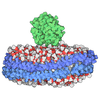[English] 日本語
 Yorodumi
Yorodumi- PDB-5irx: Structure of TRPV1 in complex with DkTx and RTX, determined in li... -
+ Open data
Open data
- Basic information
Basic information
| Entry | Database: PDB / ID: 5irx | |||||||||||||||
|---|---|---|---|---|---|---|---|---|---|---|---|---|---|---|---|---|
| Title | Structure of TRPV1 in complex with DkTx and RTX, determined in lipid nanodisc | |||||||||||||||
 Components Components |
| |||||||||||||||
 Keywords Keywords | TRANSPORT PROTEIN / TRP / ion channel / nanodisc / vanilloid / lipid | |||||||||||||||
| Function / homology |  Function and homology information Function and homology informationnegative regulation of establishment of blood-brain barrier / response to capsazepine / sensory perception of mechanical stimulus / peptide secretion / cellular response to temperature stimulus / excitatory extracellular ligand-gated monoatomic ion channel activity / temperature-gated ion channel activity / detection of chemical stimulus involved in sensory perception of pain / TRP channels / smooth muscle contraction involved in micturition ...negative regulation of establishment of blood-brain barrier / response to capsazepine / sensory perception of mechanical stimulus / peptide secretion / cellular response to temperature stimulus / excitatory extracellular ligand-gated monoatomic ion channel activity / temperature-gated ion channel activity / detection of chemical stimulus involved in sensory perception of pain / TRP channels / smooth muscle contraction involved in micturition / fever generation / urinary bladder smooth muscle contraction / detection of temperature stimulus involved in thermoception / thermoception / ion channel regulator activity / cellular response to acidic pH / negative regulation of systemic arterial blood pressure / chloride channel regulator activity / response to pH / dendritic spine membrane / glutamate secretion / monoatomic cation transmembrane transporter activity / cellular response to ATP / negative regulation of heart rate / ligand-gated monoatomic ion channel activity / response to pain / cellular response to alkaloid / temperature homeostasis / diet induced thermogenesis / cellular response to cytokine stimulus / detection of temperature stimulus involved in sensory perception of pain / intracellularly gated calcium channel activity / behavioral response to pain / negative regulation of mitochondrial membrane potential / calcium ion import across plasma membrane / monoatomic cation channel activity / extracellular ligand-gated monoatomic ion channel activity / sensory perception of pain / phosphatidylinositol binding / phosphoprotein binding / microglial cell activation / cellular response to nerve growth factor stimulus / calcium ion transmembrane transport / GABA-ergic synapse / calcium channel activity / cellular response to growth factor stimulus / response to peptide hormone / lipid metabolic process / positive regulation of nitric oxide biosynthetic process / calcium ion transport / transmembrane signaling receptor activity / cellular response to tumor necrosis factor / sensory perception of taste / cellular response to heat / positive regulation of cytosolic calcium ion concentration / response to heat / toxin activity / monoatomic ion transmembrane transport / protein homotetramerization / postsynaptic membrane / neuron projection / calmodulin binding / positive regulation of apoptotic process / external side of plasma membrane / neuronal cell body / lipid binding / dendrite / negative regulation of transcription by RNA polymerase II / extracellular region / ATP binding / metal ion binding / identical protein binding / membrane / plasma membrane Similarity search - Function | |||||||||||||||
| Biological species |   Haplopelma schmidti (Chinese earth tiger) Haplopelma schmidti (Chinese earth tiger) | |||||||||||||||
| Method | ELECTRON MICROSCOPY / single particle reconstruction / cryo EM / Resolution: 2.95 Å | |||||||||||||||
 Authors Authors | Gao, Y. / Cao, E. / Julius, D. / Cheng, Y. | |||||||||||||||
| Funding support |  United States, 4items United States, 4items
| |||||||||||||||
 Citation Citation |  Journal: Nature / Year: 2016 Journal: Nature / Year: 2016Title: TRPV1 structures in nanodiscs reveal mechanisms of ligand and lipid action. Authors: Yuan Gao / Erhu Cao / David Julius / Yifan Cheng /  Abstract: When integral membrane proteins are visualized in detergents or other artificial systems, an important layer of information is lost regarding lipid interactions and their effects on protein structure. ...When integral membrane proteins are visualized in detergents or other artificial systems, an important layer of information is lost regarding lipid interactions and their effects on protein structure. This is especially relevant to proteins for which lipids have both structural and regulatory roles. Here we demonstrate the power of combining electron cryo-microscopy with lipid nanodisc technology to ascertain the structure of the rat TRPV1 ion channel in a native bilayer environment. Using this approach, we determined the locations of annular and regulatory lipids and showed that specific phospholipid interactions enhance binding of a spider toxin to TRPV1 through formation of a tripartite complex. Furthermore, phosphatidylinositol lipids occupy the binding site for capsaicin and other vanilloid ligands, suggesting a mechanism whereby chemical or thermal stimuli elicit channel activation by promoting the release of bioactive lipids from a critical allosteric regulatory site. | |||||||||||||||
| History |
|
- Structure visualization
Structure visualization
| Movie |
 Movie viewer Movie viewer |
|---|---|
| Structure viewer | Molecule:  Molmil Molmil Jmol/JSmol Jmol/JSmol |
- Downloads & links
Downloads & links
- Download
Download
| PDBx/mmCIF format |  5irx.cif.gz 5irx.cif.gz | 334.7 KB | Display |  PDBx/mmCIF format PDBx/mmCIF format |
|---|---|---|---|---|
| PDB format |  pdb5irx.ent.gz pdb5irx.ent.gz | 252 KB | Display |  PDB format PDB format |
| PDBx/mmJSON format |  5irx.json.gz 5irx.json.gz | Tree view |  PDBx/mmJSON format PDBx/mmJSON format | |
| Others |  Other downloads Other downloads |
-Validation report
| Summary document |  5irx_validation.pdf.gz 5irx_validation.pdf.gz | 2.1 MB | Display |  wwPDB validaton report wwPDB validaton report |
|---|---|---|---|---|
| Full document |  5irx_full_validation.pdf.gz 5irx_full_validation.pdf.gz | 2.1 MB | Display | |
| Data in XML |  5irx_validation.xml.gz 5irx_validation.xml.gz | 63.8 KB | Display | |
| Data in CIF |  5irx_validation.cif.gz 5irx_validation.cif.gz | 90.4 KB | Display | |
| Arichive directory |  https://data.pdbj.org/pub/pdb/validation_reports/ir/5irx https://data.pdbj.org/pub/pdb/validation_reports/ir/5irx ftp://data.pdbj.org/pub/pdb/validation_reports/ir/5irx ftp://data.pdbj.org/pub/pdb/validation_reports/ir/5irx | HTTPS FTP |
-Related structure data
| Related structure data |  8117MC  8118C  8119C  8120C  5irzC  5is0C M: map data used to model this data C: citing same article ( |
|---|---|
| Similar structure data | |
| EM raw data |  EMPIAR-10059 (Title: Structure of TRPV1 in complex with DkTx and RTX, determined in lipid nanodisc EMPIAR-10059 (Title: Structure of TRPV1 in complex with DkTx and RTX, determined in lipid nanodiscData size: 93.8 Data #1: Motion corrected, dose-weighted sum of micrographs of TRPV1-DkTx/RTX embedded in lipid nanodisc [micrographs - single frame] Data #2: Raw particle image stack of TRPV1-DkTx/RTX embedded in lipid nanodisc [picked particles - multiframe - unprocessed]) |
- Links
Links
- Assembly
Assembly
| Deposited unit | 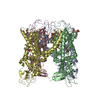
|
|---|---|
| 1 |
|
- Components
Components
-Protein , 2 types, 6 molecules ABCDEF
| #1: Protein | Mass: 72959.297 Da / Num. of mol.: 4 / Fragment: UNP residues 110-603, 627-764 Source method: isolated from a genetically manipulated source Source: (gene. exp.)   Homo sapiens (human) / References: UniProt: O35433 Homo sapiens (human) / References: UniProt: O35433#2: Protein | Mass: 8552.988 Da / Num. of mol.: 2 Source method: isolated from a genetically manipulated source Source: (gene. exp.)  Haplopelma schmidti (Chinese earth tiger) Haplopelma schmidti (Chinese earth tiger)Plasmid: pET19 / Production host:  |
|---|
-Non-polymers , 4 types, 20 molecules 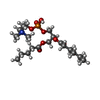

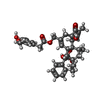
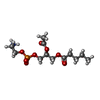



| #3: Chemical | ChemComp-6O8 / ( #4: Chemical | ChemComp-6OE / ( #5: Chemical | ChemComp-6EU / #6: Chemical | ChemComp-6O9 / ( |
|---|
-Details
| Has protein modification | Y |
|---|
-Experimental details
-Experiment
| Experiment | Method: ELECTRON MICROSCOPY |
|---|---|
| EM experiment | Aggregation state: PARTICLE / 3D reconstruction method: single particle reconstruction |
- Sample preparation
Sample preparation
| Component |
| ||||||||||||||||||||||||||||
|---|---|---|---|---|---|---|---|---|---|---|---|---|---|---|---|---|---|---|---|---|---|---|---|---|---|---|---|---|---|
| Source (natural) |
| ||||||||||||||||||||||||||||
| Source (recombinant) |
| ||||||||||||||||||||||||||||
| Buffer solution | pH: 7.4 | ||||||||||||||||||||||||||||
| Buffer component |
| ||||||||||||||||||||||||||||
| Specimen | Conc.: 0.5 mg/ml / Embedding applied: NO / Shadowing applied: NO / Staining applied: NO / Vitrification applied: YES / Details: This sample was monodisperse. | ||||||||||||||||||||||||||||
| Specimen support | Grid material: COPPER / Grid mesh size: 400 divisions/in. / Grid type: Quantifoil R1.2/1.3 | ||||||||||||||||||||||||||||
| Vitrification | Instrument: FEI VITROBOT MARK III / Cryogen name: ETHANE / Humidity: 100 % / Chamber temperature: 278 K Details: Blot for 6 seconds before plunging into liquid ethane (FEI VITROBOT MARK III). |
- Electron microscopy imaging
Electron microscopy imaging
| Experimental equipment |  Model: Tecnai Polara / Image courtesy: FEI Company |
|---|---|
| Microscopy | Model: FEI POLARA 300 / Details: Grid screening was performed manually. |
| Electron gun | Electron source:  FIELD EMISSION GUN / Accelerating voltage: 300 kV / Illumination mode: FLOOD BEAM FIELD EMISSION GUN / Accelerating voltage: 300 kV / Illumination mode: FLOOD BEAM |
| Electron lens | Mode: BRIGHT FIELD / Nominal magnification: 31000 X / Calibrated magnification: 41132 X / Nominal defocus max: 2200 nm / Nominal defocus min: 700 nm / Calibrated defocus min: 700 nm / Calibrated defocus max: 2200 nm / Cs: 2 mm / C2 aperture diameter: 30 µm / Alignment procedure: COMA FREE |
| Specimen holder | Cryogen: NITROGEN / Specimen holder model: OTHER / Temperature (max): 70 K / Temperature (min): 70 K |
| Image recording | Average exposure time: 6 sec. / Electron dose: 41 e/Å2 / Detector mode: SUPER-RESOLUTION / Film or detector model: GATAN K2 SUMMIT (4k x 4k) / Num. of grids imaged: 1 / Num. of real images: 1200 Details: Images were collected in movie mode at 5 frames per second for 6 seconds. |
| Image scans | Width: 3838 / Height: 3710 / Movie frames/image: 30 / Used frames/image: 1-30 |
- Processing
Processing
| Software | Name: PHENIX / Version: 1.10_2152: / Classification: refinement | |||||||||||||||||||||||||||||||||||||||||||||||||||||||
|---|---|---|---|---|---|---|---|---|---|---|---|---|---|---|---|---|---|---|---|---|---|---|---|---|---|---|---|---|---|---|---|---|---|---|---|---|---|---|---|---|---|---|---|---|---|---|---|---|---|---|---|---|---|---|---|---|
| EM software |
| |||||||||||||||||||||||||||||||||||||||||||||||||||||||
| Image processing | Details: Each image stack was subjected to whole-frame motion correction followed by correction at the individual pixel level using program UcsfDfCorr. | |||||||||||||||||||||||||||||||||||||||||||||||||||||||
| CTF correction | Details: CTF correction was performed before classification and refinement. Type: PHASE FLIPPING AND AMPLITUDE CORRECTION | |||||||||||||||||||||||||||||||||||||||||||||||||||||||
| Particle selection | Num. of particles selected: 218787 Details: Initial manual particle picking and automatic particle picking were performed using SamViewer and several python scripts based on SPIDER. | |||||||||||||||||||||||||||||||||||||||||||||||||||||||
| Symmetry | Point symmetry: C4 (4 fold cyclic) | |||||||||||||||||||||||||||||||||||||||||||||||||||||||
| 3D reconstruction | Resolution: 2.95 Å / Resolution method: FSC 0.143 CUT-OFF / Num. of particles: 73929 / Num. of class averages: 2 / Symmetry type: POINT | |||||||||||||||||||||||||||||||||||||||||||||||||||||||
| Atomic model building | Protocol: RIGID BODY FIT / Space: REAL / Target criteria: correlation coefficient | |||||||||||||||||||||||||||||||||||||||||||||||||||||||
| Atomic model building | PDB-ID: 3J5Q Pdb chain-ID: A / Accession code: 3J5Q / Source name: PDB / Type: experimental model | |||||||||||||||||||||||||||||||||||||||||||||||||||||||
| Refinement | Highest resolution: 2.95 Å | |||||||||||||||||||||||||||||||||||||||||||||||||||||||
| Refine LS restraints |
|
 Movie
Movie Controller
Controller




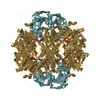
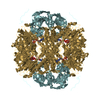
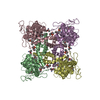
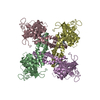
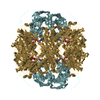
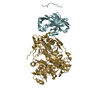


 PDBj
PDBj
